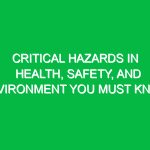Introduction
Welding safety is a critical aspect of the Health, Safety, and Environment (HSE) domain. It encompasses a vast range of practices designed to protect welders from potential hazards associated with various welding processes. With the growing demand for skilled welders in industries such as construction, manufacturing, and automotive, ensuring a safe work environment is more crucial than ever. This article explores essential welding safety tips that contribute to a risk-free work environment and emphasizes the importance of adhering to safety protocols. By understanding the risks and implementing effective safety measures, professionals can significantly reduce accidents and injuries in the workplace.
Understanding Welding Hazards
Welding involves joining materials, typically metals, using heat and pressure. While this process is vital to many industries, it poses several hazards that can endanger the welder’s health and safety. Understanding these risks is the first step toward effective welding safety.
- Fumes and Gases: Welding produces harmful fumes, including metal oxides and gases like ozone and nitrogen dioxide. Inhalation of these substances can lead to respiratory issues, long-term health problems, or even acute poisoning.
- Fire and Explosions: The intense heat generated during welding can ignite flammable materials nearby. This risk is particularly heightened in environments with combustible substances, which can lead to catastrophic fires or explosions.
- Electrical Hazards: Welders often work with high-voltage equipment, posing a risk of electric shock. Proper grounding and insulation are crucial to preventing these incidents.
- Burns and Injuries: The heat from welding equipment can cause severe burns. Additionally, flying sparks and molten metal can cause injuries if proper protective gear is not worn.
Understanding these hazards is essential for welders to take proactive measures to ensure their safety and that of their colleagues.
Key Welding Safety Practices
To mitigate the risks associated with welding, it is essential to implement comprehensive safety practices. Here are some key tips for ensuring welding safety in the workplace:
1. Personal Protective Equipment (PPE)
Proper personal protective equipment (PPE) is the first line of defense against welding hazards. Welders should always wear the following:
- Welding Helmets: A helmet with a proper shade lens protects the eyes from harmful UV and infrared light, as well as flying sparks.
- Gloves: Heavy-duty gloves protect the hands from heat and sparks while allowing for dexterity.
- Protective Clothing: Flame-resistant clothing helps prevent burns from sparks and molten metal.
- Respirators: In environments with hazardous fumes, respirators equipped with appropriate filters can prevent respiratory issues.
Investing in high-quality PPE tailored to the specific welding process and environment is non-negotiable when ensuring safety.
2. Adequate Ventilation
Welding generates dangerous fumes, making proper ventilation critical. Adequate airflow helps disperse harmful gases and fumes, reducing the risk of respiratory diseases. Consider the following tips for ensuring proper ventilation:
- Use exhaust systems to remove fumes and gases from the workspace.
- Open windows and doors to create cross-ventilation.
- Consider using portable ventilation systems in confined spaces.
Maintaining a well-ventilated workspace is essential for the health and safety of all personnel involved in welding operations.
3. Fire Safety Precautions
Given the fire hazards associated with welding, it is imperative to establish strict fire safety protocols. Here are some practices to consider:
- Keep a fire extinguisher on-site, ensuring all personnel are trained to use it effectively.
- Establish a fire watch for high-risk welding activities, especially in areas with flammable materials.
- Remove or protect combustible materials within a 35-foot radius before starting welding operations.
By adhering to these fire safety precautions, welders can significantly reduce the risk of fires and protect themselves and their coworkers.
4. Equipment Safety Checks
Regular inspections and maintenance of welding equipment are crucial for ensuring safety. Before starting any welding project, a welder should check for the following:
- Inspect cables for wear and tear, ensuring they are in good condition and free from damage.
- Check gas connections and hoses for leaks, particularly in gas welding applications.
- Ensure that all safety features, such as circuit breakers and emergency shut-offs, are functioning.
By proactively monitoring equipment condition, welders can prevent malfunctions and accidents during welding operations.
5. Training and Awareness
Comprehensive training programs are essential for promoting welding safety. Employers should implement the following training initiatives:
- Provide thorough training on welding techniques and equipment operation.
- Conduct regular safety drills to prepare welders for emergency situations.
- Encourage open communication about safety concerns and best practices among team members.
Real-life case studies illustrate the importance of training. For instance, a manufacturing facility that implemented a robust safety training program saw a 50% decrease in welding-related injuries over two years. This highlights how ongoing education can transform a workplace culture toward safety.
6. Proper Work Environment
Creating a safe work environment involves more than just individual precautions; it also requires attention to the workspace itself. Consider the following:
- Ensure that work areas are clean and free from clutter to prevent trip hazards.
- Maintain proper lighting to enhance visibility and reduce the risk of accidents.
- Organize tools and equipment to minimize distractions and improve efficiency.
A well-organized and maintained work environment contributes significantly to welding safety.
Regulations and Standards
Welding safety is not only a matter of best practices; it is also governed by regulations and standards set forth by various organizations. Some key regulations include:
- Occupational Safety and Health Administration (OSHA): OSHA provides regulations related to workplace safety, including exposure limits for hazardous substances and requirements for PPE.
- American National Standards Institute (ANSI): ANSI develops standards for personal protective equipment and safety practices within the welding industry.
- National Fire Protection Association (NFPA): NFPA sets standards for fire safety, including guidelines for welding operations in environments with flammable materials.
Compliance with these regulations not only protects welders but also promotes a culture of safety within the industry.
Conclusion
Welding safety is a vital component of the Health, Safety, and Environment domain, emphasizing the need for robust practices to protect welders from potential hazards. By understanding welding risks and implementing essential safety tips, professionals can significantly reduce accidents and foster a culture of safety in the workplace. From wearing appropriate PPE and ensuring adequate ventilation to conducting regular equipment checks and adhering to regulations, every action contributes to a safer work environment. The commitment to welding safety ultimately enhances overall productivity and protects the health and well-being of all personnel involved. As industry standards evolve, continuous improvement and education will remain essential in promoting a risk-free welding environment.


